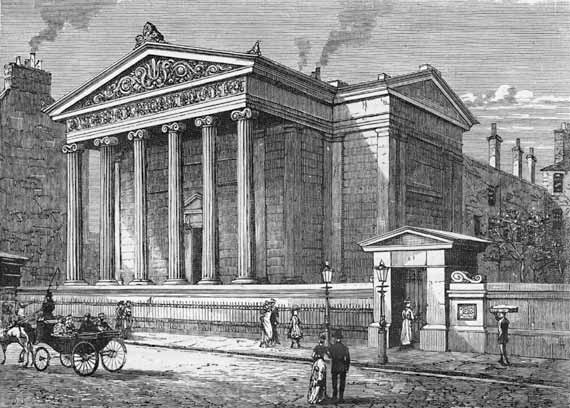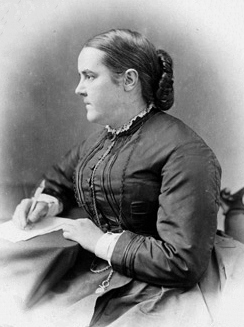|
Surgeons' Hall Riot
The Surgeons' Hall Riot (18 November 1870) was a defining moment in the campaign of the Edinburgh Seven, a group of women fighting for the right to train and practice as doctors. It created a groundswell of support for the women's campaign, and also led to a well documented libel case against Sophia Jex-Blake. The riot On 18 November 1870, the women were to attend an anatomy exam at Surgeons' Hall in Edinburgh. As they approached the building, they were confronted by a large crowd of students and several hundred onlookers. They were verbally abused and pelted with refuse, and the gate to the building was slammed in their face. They were eventually able to gain access to the hall — some resources state that access was facilitated by helpful janitorial staff, while others assert that the women were assisted by sympathetic male students. Several disruptive students were ejected from the building to allow the examination to proceed, however it was further interrupted when a live ... [...More Info...] [...Related Items...] OR: [Wikipedia] [Google] [Baidu] |
Surgeons Hall
Surgeons' Hall in Edinburgh, Scotland, is the headquarters of the Royal College of Surgeons of Edinburgh (RCSEd). It houses the Surgeons' Hall Museum, and the library and archive of the RCSEd. The present Surgeons' Hall was designed by William Henry Playfair and completed in 1832, and is a category A listed building. Surgeons' Hall Museum is the major medical museum in Scotland, and one of Edinburgh's many tourist attractions. The museum is recognised as a collection of national significance by the Scottish Government. The museum reopened in September 2015, after being closed for an eighteen-month period of redevelopment. History Origins The Royal College of Surgeons of Edinburgh was incorporated in 1505, when it received its Seal of Cause or charter and became styled as "The Incorporation of Surgeons and Barbers of Edinburgh". The Museum at Surgeons Hall, Edinburgh dates from 1699 when the Incorporation announced that they were making a collection of ‘natural and artific ... [...More Info...] [...Related Items...] OR: [Wikipedia] [Google] [Baidu] |
Edinburgh Seven
The Edinburgh Seven were the first group of matriculated undergraduate female students at any British university. They began studying medicine at the University of Edinburgh in 1869 and, although the Court of Session ruled that they should never have been admitted, and they did not graduate or qualify as doctors, the campaign they fought gained national attention and won them many supporters, including Charles Darwin. Their campaign put the demands of women for a university education on the national political agenda, which eventually resulted in legislation to ensure that women could study medicine at university in 1876 ( UK Medical Act 1876). The group was also called the Septem contra Edinam ("Seven against Edinburgh", in reference to the Seven against Thebes of Greek mythology). Although over the four-year campaign some of the original seven left and others joined, the following women became known as the Edinburgh Seven: * Sophia Jex-Blake * Isabel Thorne * Edith Pechey * ... [...More Info...] [...Related Items...] OR: [Wikipedia] [Google] [Baidu] |
Sophia Jex-Blake
Sophia Louisa Jex-Blake (21 January 1840 – 7 January 1912) was an English physician, teacher and feminist. She led the campaign to secure women access to a University education when she and six other women, collectively known as the Edinburgh Seven, began studying medicine at the University of Edinburgh in 1869. She was the first practising female doctor in Scotland, and one of the first in the wider United Kingdom of Great Britain and Ireland; a leading campaigner for medical education for women and was involved in founding two medical schools for women, in London and Edinburgh at a time when no other medical schools were training women. Early life Sophia Jex-Blake was born at 3 Croft Place Hastings, England on 21 January 1840, daughter of retired lawyer Thomas Jex-Blake, a proctor of Doctors' Commons, and Mary Jex-Blake (née Cubitt).Shirley Roberts‘Blake, Sophia Louisa Jex- (1840–1912)’ ''Oxford Dictionary of National Biography'', Oxford University Press, 2004, a ... [...More Info...] [...Related Items...] OR: [Wikipedia] [Google] [Baidu] |
Surgeons' Hall
Surgeons' Hall in Edinburgh, Scotland, is the headquarters of the Royal College of Surgeons of Edinburgh (RCSEd). It houses the Surgeons' Hall Museum, and the library and archive of the RCSEd. The present Surgeons' Hall was designed by William Henry Playfair and completed in 1832, and is a category A listed building. Surgeons' Hall Museum is the major medical museum in Scotland, and one of Edinburgh's many tourist attractions. The museum is recognised as a collection of national significance by the Scottish Government. The museum reopened in September 2015, after being closed for an eighteen-month period of redevelopment. History Origins The Royal College of Surgeons of Edinburgh was incorporated in 1505, when it received its Seal of Cause or charter and became styled as "The Incorporation of Surgeons and Barbers of Edinburgh". The Museum at Surgeons Hall, Edinburgh dates from 1699 when the Incorporation announced that they were making a collection of ‘natural and artific ... [...More Info...] [...Related Items...] OR: [Wikipedia] [Google] [Baidu] |
Robert Christison
Sir Robert Christison, 1st Baronet, (18 July 1797 – 27 January 1882) was a Scottish toxicologist and physician who served as president of the Royal College of Physicians of Edinburgh (1838–40 and 1846-8) and as president of the British Medical Association (1875). He was the first person to describe renal anaemia. Life Christison was born at 144 Nicolson Street in Edinburgh, the son of Margaret Johnstone and Alexander Christison FRSE (1753–1820). He was a twin, his elder brother (by a few minutes) being later Rev. Alexander Christison (1797–1874). He attended the Royal High School before studying medicine at University of Edinburgh, graduating in 1819. At this time the family were living at 4 Argyll Square. He then spent a short time in London, studying under John Abernethy and Sir William Lawrence, and in Paris, where he learned analytical chemistry from Pierre Robiquet and toxicology from Mathieu Orfila. In 1822 he returned to Edinburgh as professor of medical ... [...More Info...] [...Related Items...] OR: [Wikipedia] [Google] [Baidu] |
Sir Robert Christison
''Sir'' is a formal honorific address in English for men, derived from Sire in the High Middle Ages. Both are derived from the old French "Sieur" (Lord), brought to England by the French-speaking Normans, and which now exist in French only as part of "Monsieur", with the equivalent "My Lord" in English. Traditionally, as governed by law and custom, Sir is used for men titled as knights, often as members of orders of chivalry, as well as later applied to baronets and other offices. As the female equivalent for knighthood is damehood, the female equivalent term is typically Dame. The wife of a knight or baronet tends to be addressed as Lady, although a few exceptions and interchanges of these uses exist. Additionally, since the late modern period, Sir has been used as a respectful way to address a man of superior social status or military rank. Equivalent terms of address for women are Madam (shortened to Ma'am), in addition to social honorifics such as Mrs, Ms or Miss. ... [...More Info...] [...Related Items...] OR: [Wikipedia] [Google] [Baidu] |
Edinburgh Seven Plaque
Edinburgh ( ; gd, Dùn Èideann ) is the capital city of Scotland and one of its 32 Council areas of Scotland, council areas. Historically part of the county of Midlothian (interchangeably Edinburghshire before 1921), it is located in Lothian on the southern shore of the Firth of Forth. Edinburgh is Scotland's List of towns and cities in Scotland by population, second-most populous city, after Glasgow, and the List of cities in the United Kingdom, seventh-most populous city in the United Kingdom. Recognised as the capital of Scotland since at least the 15th century, Edinburgh is the seat of the Scottish Government, the Scottish Parliament and the Courts of Scotland, highest courts in Scotland. The city's Holyrood Palace, Palace of Holyroodhouse is the official residence of the Monarchy of the United Kingdom, British monarchy in Scotland. The city has long been a centre of education, particularly in the fields of medicine, Scots law, Scottish law, literature, philosophy, the sc ... [...More Info...] [...Related Items...] OR: [Wikipedia] [Google] [Baidu] |


.jpg)

